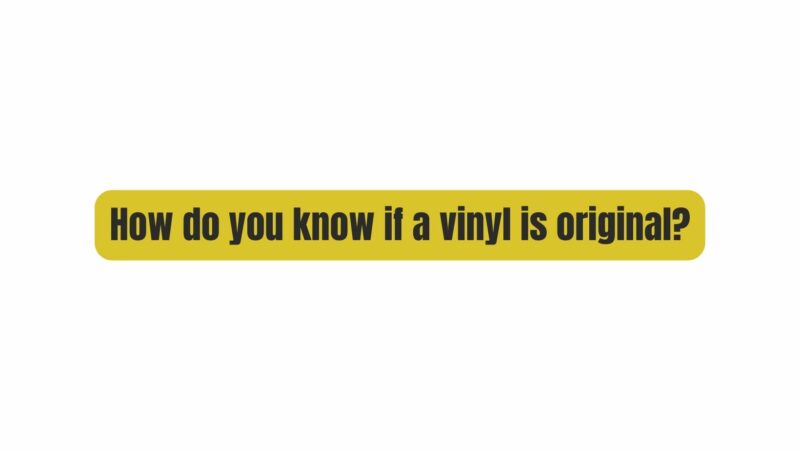in an era where vinyl records are experiencing a resurgence in popularity, collectors and enthusiasts often find themselves on a quest for original pressings—those elusive artifacts that capture the essence of a particular era or artist. But how can you tell if a vinyl record is an original release? Discerning the authenticity of vinyl records can be a nuanced and rewarding pursuit. In this article, we will unravel the secrets and share valuable insights into how to identify if a vinyl record is an original pressing.
Understanding the Terminology
Before diving into the specifics of authenticating vinyl records, it’s essential to familiarize ourselves with some key terminology:
- Original Pressing: An original pressing is the initial release of a vinyl record when it first comes out. These are typically the most sought-after editions due to their historical significance and potential rarity.
- Reissue: A reissue is a subsequent release of a vinyl record, often many years after the original pressing. Reissues can vary in quality and desirability.
- Bootleg: A bootleg is an unauthorized or illegal reproduction of a vinyl record. Bootlegs are usually of inferior quality and lack the official markings of legitimate releases.
- Counterfeit: Counterfeit records are unauthorized copies that aim to mimic the appearance of original pressings. These can be more challenging to spot than bootlegs.
Factors to Consider When Authenticating Vinyl Records
Identifying an original vinyl pressing involves a combination of factors, including:
1. Label and Catalog Number
One of the most critical indicators of authenticity is the label and catalog number. Original pressings will have the correct label for the release, often with specific variations in label design or color for different pressings. The catalog number should match the official release. Consult discography databases and resources specific to the artist or record label for accurate information.
2. Matrix Runout
The matrix runout is etched or stamped into the runout groove area of the vinyl record. It typically contains a combination of letters and numbers that can provide clues about the record’s origin. This information may include the pressing plant, mastering engineer, and the catalog number. Comparing the matrix runout to known original pressings can help verify authenticity.
3. Cover and Packaging
The album cover and packaging can offer insights into authenticity. Pay attention to the cover’s design, artwork, and printing quality. Original pressings often feature specific details that may not be present on reissues or counterfeits. Look for original shrink-wrap, stickers, or inserts that were included with the release.
4. Vinyl Weight and Color
The weight and color of the vinyl can vary between original pressings and reissues. Original pressings are often heavier and may have unique color variations, such as marbled or translucent vinyl. Compare the weight and appearance of the vinyl to known originals.
5. Copyright and Publishing Information
Check the copyright and publishing information on the record label, cover, and inner sleeves. These details should match the known release information for the original pressing. Discrepancies or errors can indicate a counterfeit or unauthorized release.
6. Country of Origin
Vinyl records may have different pressings for various countries or regions. Knowing the country of origin for the release can help determine authenticity. Research the discography of the artist to identify which countries produced original pressings.
7. Vinyl Condition
The condition of the vinyl itself can be a clue to authenticity. Original pressings are often well cared for by collectors and may exhibit minimal signs of wear or use. Be cautious of records that appear excessively worn or damaged, as they may be reissues or counterfeits.
8. Sound Quality
The sound quality of a vinyl record can also provide clues. Original pressings are often praised for their superior audio quality compared to reissues or counterfeits. A well-trained ear may discern differences in sound between original and reissued pressings.
9. Historical Research
Extensive research on the artist, album, and record label can provide historical context and insights into the authenticity of a vinyl record. Explore collector forums, discography databases, and reference books specific to the genre or artist to gather information.
Conclusion
Authenticating a vinyl record as an original pressing can be a rewarding endeavor for collectors and enthusiasts. It requires a combination of careful examination, research, and attention to detail. While the process may seem daunting, the pursuit of an original pressing adds to the allure and satisfaction of vinyl collecting. Remember that authentication is not always straightforward, and the presence of some factors may not guarantee authenticity. Utilize resources, seek expert opinions when necessary, and continue to refine your skills in identifying original vinyl records. With dedication and patience, you can uncover the treasure of an original pressing and enjoy the authentic sound and history it represents.


